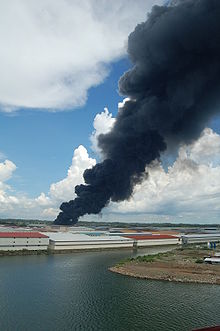- Colón Free Trade Zone
-
The Colón Free Trade Zone is a gigantic entity at the Atlantic gateway to the Panamá Canal, dedicated to re-export an enormous variety of merchandise to Latin America and the Caribbean. It is also the largest free zone in the Americas and second largest in the world. It started operations in 1948 and occupies about 600 acres (2.4 km2). It is located near the Atlantic Entrance of the Panamá Canal. Divided in two large areas: one located in Colón, segregated from the city itself by a wall; and the other relatively new, in the Harbour area, which is designated for warehouses covering 130 acres (0.53 km2) and at a distance of only 400 yards (370 m) from the Colón commercial sector.
Contents
Origins
Since 1917, only three years after the opening of the Panamá Canal, the possibility of having a free zone area in Colón was discussed. It was not however, until the end of World War II that the idea became substance. During the war, many locals obtained employment in the construction of defense facilities and facilities to provide services for the movement of troops, and with the end of troop arrivals, came the hard times. Later, Dr. Enrique A. Jimenez, President of the Republic in 1945, took the initiative to make the free zone project a reality, making use of the geographic position of the ports and the interoceanic waterway, a compulsory route for worldwide navigation. He recommended the reconsideration of a project prepared by George E. Roberts, Vice President of the First National City Bank of New York, which contemplated the creation of a free zone area in Colón and which had been submitted to the Government in 1929.
In 1946, the Government employed Dr. Thomas E. Lyons, renowned authority on free zones, to carry out a feasibility study in the area suggested for the project. Based on his recommendations, the Government approved Law No 18 of June 17, 1948, which creates the Colón Free Zone as an autonomous institution.
Progress
Nowadays, the Colón Free Zone receives more than 250,000 visitors a year and has 1,751 companies established in this place and generates exports and re-exports valued at more than US$6.5 billion in 2005, which can count on all the services and facilities offered by the Free Zone, for importing, storing, assembling, re-packing and re-exporting products from all over the world: from all types of electric appliances to pharmaceutical products, liquor, cigarettes, office and home furniture, clothing, shoes, jewelry, toys, etc. It is considered the "Trading Showcase" of Central and South America as well as for the Caribbean region.
The Colón free Zone is an important Transshipped supplier of goods to other free zones such as Hong Kong (China) followed by Taiwan, United States, Japan, Korea, France, Mexico, Italy, Puerto Rico, Switzerland, United Kingdom, Malaysia and Germany. These countries supplied nearly 87 percent of all Colón Free Zone imports in 2004. Colombia is the largest buyer of merchandise, buying nearly 16 percent of all Colón Free Zone exports. Other principal buyers are Venezuela, Panama (domestic market), Guatemala, Ecuador, Costa Rica, Dominican Republic, the United States, Chile, Cuba, Honduras, Peru, Brazil, Nicaragua and El Salvador. These countries buy approximately 83% of all exports from the Colón Free Zone. All that gives the Colón Free Zone the right to be called "The First Free zone of the Western Hemisphere".
The existence of modern seaports with the most modern facilities, container ports, direct access through the Pan-American Highway, air access, and trains daily transporting containers from the Pacific Ocean to the Atlantic Ocean. Dividends arising from external operations or from those operations that are executed or consumed abroad are tax-free. There are no Capital Investment Taxes. Municipal and Local Taxes do not apply to firms operating in the Free Zone and there are no taxes on shipments to or from the Free Zone from or to anywhere in the world.
See also
- Mellander, Gustavo A.; Nelly Maldonado Mellander (1999). Charles Edward Magoon: The Panama Years. Río Piedras, Puerto Rico: Editorial Plaza Mayor. ISBN 1-56328-155-4. OCLC 42970390.
- Mellander, Gustavo A. (1971). The United States in Panamanian Politics: The Intriguing Formative Years. Danville, Ill.: Interstate Publishers. OCLC 138568.
- Index of international trade articles
- Multinational corporation
- Trade
- Free trade area
External links
Categories:- International trade
- Economy of Panama
- States and territories established in 1948
- Colón, Panama
Wikimedia Foundation. 2010.

